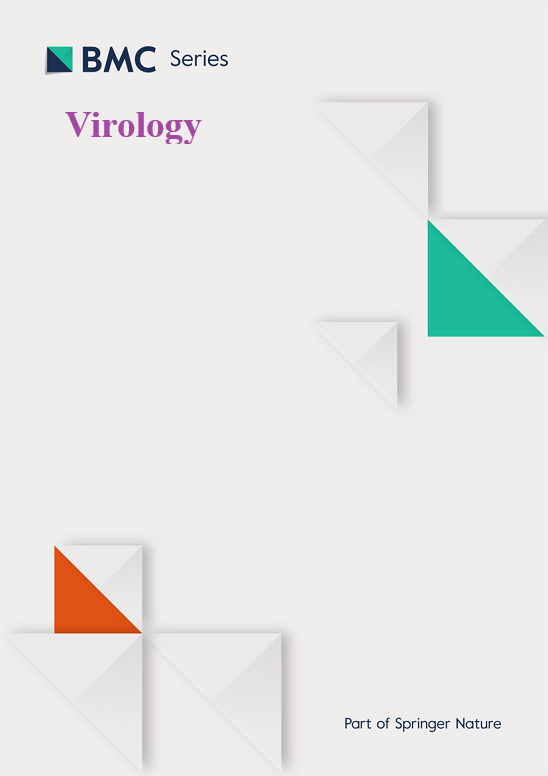Targeting the host protein G3BP1 for the discovery of novel antiviral inhibitors against Chikungunya virus
IF 2.8
3区 医学
Q3 VIROLOGY
引用次数: 0
Abstract
The molecular interactions between Chikungunya virus (CHIKV) non-structural protein 3 (nsP3) and the host GTPase Activating SH3 Domain Binding Protein 1 (G3BP1) are critical for CHIKV replication. The C-terminus hypervariable domain (HVD) of nsP3 protein binds to the nuclear transport factor 2 (NTF2)-like domain of G3BP1 through two tandem FGDF motifs, aiding in the disruption of stress granule (SG) formation. Given G3BP1's role in the antiviral response, it presents an attractive target for antiviral drug development. In this study, seven potential small molecules targeting the FGDF motif binding pocket of G3BP1 were identified using a structure-based virtual screening approach. The binding modes of these molecules were further investigated through molecular docking and simulations. Surface Plasmon Resonance (SPR) and Isothermal Titration Calorimetry (ITC) experiments confirmed their binding to purified G3BP1 with micromolar (μM) affinity. The antiviral efficacy of these molecules was assessed using in vitro cell culture-based assays, revealing that L-7, WIN, SB2, NAL, DHD, GSK, and FLU effectively inhibited CHIKV replication with EC50 values of 1.99, 0.40, 5.38, 1.52, 7.39, 3.66, and 0.61 μM, respectively. Additionally, CHIKV-infected cells treated with these compounds exhibited fewer virus-induced SGs compared to untreated controls without affecting SG formation under oxidative stress conditions. These findings indicate that identified inhibitors successfully block G3BP1-nsP3 interactions and suppress CHIKV replication. This is one of the first reports of small antiviral molecules targeting G3BP1, a host protein essential for stress granule formation in the antiviral cellular response and CHIKV replication.
靶向宿主蛋白G3BP1发现新的基孔肯雅病毒抗病毒抑制剂
基孔肯雅病毒(CHIKV)非结构蛋白3 (nsP3)与宿主GTPase激活SH3结构域结合蛋白1 (G3BP1)之间的分子相互作用是基孔肯雅病毒复制的关键。nsP3蛋白的c端高变结构域(HVD)通过两个串联的FGDF基序与G3BP1的核转运因子2 (NTF2)样结构域结合,有助于破坏应激颗粒(SG)的形成。鉴于G3BP1在抗病毒反应中的作用,它为抗病毒药物开发提供了一个有吸引力的靶点。在这项研究中,使用基于结构的虚拟筛选方法鉴定了7个靶向G3BP1的FGDF基序结合口袋的潜在小分子。通过分子对接和模拟进一步研究了这些分子的结合模式。表面等离子体共振(SPR)和等温滴定量热(ITC)实验证实了它们与纯化G3BP1的结合具有微摩尔(μM)亲和力。结果表明,L-7、WIN、SB2、NAL、DHD、GSK和FLU均能有效抑制CHIKV病毒复制,EC50值分别为1.99、0.40、5.38、1.52、7.39、3.66和0.61 μM。此外,与未处理的对照组相比,用这些化合物处理的chikv感染细胞在氧化应激条件下表现出更少的病毒诱导的SGs,而不影响SG的形成。这些发现表明所鉴定的抑制剂成功阻断G3BP1-nsP3相互作用并抑制CHIKV复制。这是首次报道针对G3BP1的小抗病毒分子,G3BP1是抗病毒细胞反应和CHIKV复制中应激颗粒形成所必需的宿主蛋白。
本文章由计算机程序翻译,如有差异,请以英文原文为准。
求助全文
约1分钟内获得全文
求助全文
来源期刊

Virology
医学-病毒学
CiteScore
6.00
自引率
0.00%
发文量
157
审稿时长
50 days
期刊介绍:
Launched in 1955, Virology is a broad and inclusive journal that welcomes submissions on all aspects of virology including plant, animal, microbial and human viruses. The journal publishes basic research as well as pre-clinical and clinical studies of vaccines, anti-viral drugs and their development, anti-viral therapies, and computational studies of virus infections. Any submission that is of broad interest to the community of virologists/vaccinologists and reporting scientifically accurate and valuable research will be considered for publication, including negative findings and multidisciplinary work.Virology is open to reviews, research manuscripts, short communication, registered reports as well as follow-up manuscripts.
 求助内容:
求助内容: 应助结果提醒方式:
应助结果提醒方式:


